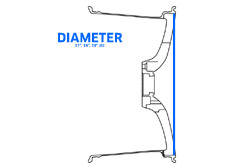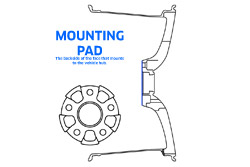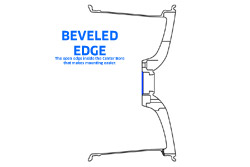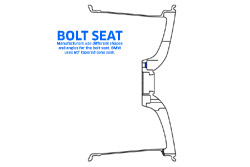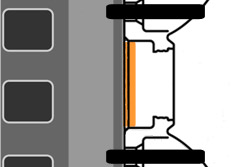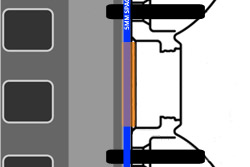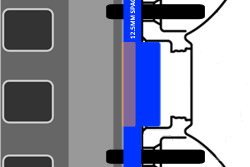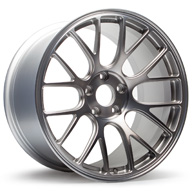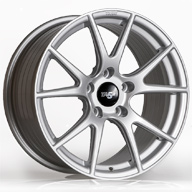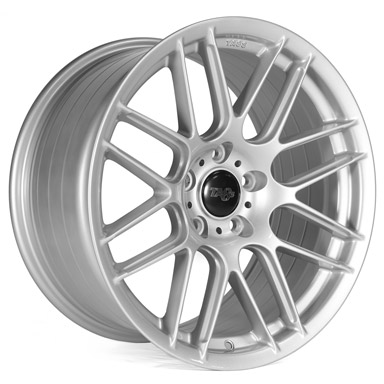|
BMW Wheel Info & Tech
BMW Wheel Recommendations by Chassis
Below we have listed common BMW models and our recommended wheel sizes from easy fitments to ultra-aggressive track sizes. We broke down our recommendations into categories of use so that we can offer a wheel for almost anyone.Stock wheel sizes are the most aggressive factory BMW option. If BMW offers it then it must fit.
Easy upgrade with a lower offset that fits within stock bodywork. You may also find wheels above and below this offset that will also work.
Mild is more aggressive than Easy (or sometimes the same) but usually fit without serious modification
Bold sizes that approach or exceed the physical fitment on the vehicle
Track A is our preferred size and offset for track use
Track B/C/D offers an alternative to our Track A recommendation when options exist.
The Bold and Track recommendations will not be direct bolt-on fitments. Our goal is to fit as much tire as possible in these fitments so compromises should be expected. Some trimming of plastic fender liners, rolling inside fenders, extra negative camber, or wheel spacers are likely required on the Bold and Track sizes. While the proper offset is best, wheel spacers are often the solution to difficult fitments. Click here for more info on spacers.
ET = wheel offset in millimeters (ET is German abbreviation for Einpresstiefe or offset).
The all-important disclaimer: we make broad size recommendations that apply to a mass audience. However, we welcome your questions on fitment, size, offset, or other wheel-related inquiries. Many variables must be considered, including: suspension type and settings, ride height, tire size, bodywork changes, and alignment settings. We intentionally left out tire sizes in our recommendations (see Tire section below). In cases of Bold, Aggressive, and Track fitments, additional parts, modifications, or alterations may be necessary for fitment that may not be listed in our catalog.
BMW Wheel Fitments by Chassis:
E82 128i/135i: the E82 squeezed E9X suspension into a tighter and smaller exterior. This dictated narrower wheels with higher offsets. Wheels over 8.5" wide are very hard to fit to the E82.
| E82 128i/135i Wheel Recommendations | |||||||
| F/R | Stock | Roll
Dia. |
Easy | Mild | Bold | Track A | Track B |
| F | 18x7.5 ET49 | 24.77" | 18x8.0 ET45 | 18x8.5 ET45 | 18x8.5 ET40 | 18x8.5 ET45 | 18x9.0 ET45 |
| R | 18x8.5 ET52 | 24.75" | 18x9.0 ET50 | 18x9.5 ET58 | 18x9.0 ET45 | 18x8.5 ET45 | 18x9.0 ET45 |
E82 1M: the 1M model of the E82 uses the suspension and brakes from the M3 but with wider fenders with more room. Just about any wheel from the E9X M3 will fit on the 1M as well.
| E82 1M Coupe Wheel Recommendations | |||||||
| F/R | Stock | Roll
Dia. |
Easy | Mild | Bold | Track A | Track B |
| F | 19x9.0 ET31 | 25.75" | 19x9.0 ET19 | 19x9.5 ET35 | 19x9.5 ET22 | 18x9.5 ET22 | 18x10 ET25 |
| R | 19x10.0 ET25 | 26.30" | 19x10.0 ET15 | 19x10.5 ET27 | 19x10.5 ET24 | 18x9.5 ET22 | 18x10 ET25 |
F22 228i-M240i: The F22 came with disappointingly small tire sizes from the factory. Again, they took the playbook from the E82 and used the suspension from a larger car in a smaller body. F22 and E82 wheel sizes and offsets are very close but with slightly lower offsets in the front. The same lack of space carries over from the E82 to the F22. Note that to fit serious rubber on the M235i Racing car BMW had to use larger fender flares.
| F22 228i/M235i Wheel Recommendations | |||||||
| F/R | Stock | Roll
Dia. |
Easy | Mild | Bold | Track A | Track B |
| F | 19x7.5 ET45 | 25.20" | 19x8.0 ET38 | 19x8.5 ET45 | 19x8.5 ET40 | 18x8.5 ET45 | 18x9.0 ET50 |
| R | 19x8.0 ET52 | 24.79" | 19x8.5 ET45 | 19x9.5 ET58 | 19x9.5 ET43 | 18x8.5 ET45 | 18x9.0 ET50 |
F87 M2: uses the same stock wheel sizes and offset as the M3/M4 but has much less room for wider wheels and tires. For the track a 9.5" wheel is a direct fit (but uses smaller rear wheel than stock). The common 10.0" size can also fit but given the limited fender space you must accept some rubbing from tire contact. We prefer the 18x10" with ET33 offset, using a spacer in the front to clear the spring perch.
| F87 M2 Wheel Recommendations | |||||||
| F/R | Stock | Roll
Dia. |
Easy | Mild | Bold | Track A | Track B |
| F | 19x9.0 ET29 | 25.75" | 19x9.0 ET24 | 19x8.5 ET28 | 18x9.5 ET35 | 18x10.0 ET33 | |
| R | 19x10.0 ET40 | 26.30" | 19x10.0 ET35 | 19x10.5 ET40 | 18x9.5 ET35 | 18x10.0 ET33 | |
E30 318i/325e/325i: the E30 was engineered in a time when 17" was a huge size. It was simply never designed for big wheels. Anything bigger than the Euro 15x7 must have the right combination of offset, tire size, and camber. And the M20 and M42 engines simply don't need much more than an 8.0" 225 tire anyway. The E30 was also the last model to use a 4-lug hub although 5-lug swaps are common.
| E30 318i/325i Wheel Recommendations | |||||||
| F/R | Stock | Roll Dia. | Easy | Mild | Bold | Track A | Track B |
| F | 15x7.0 ET24 | 23.88" | 17x8.0 ET25 | ||||
| R | 15x7.0 ET24 | 23.88" | 17x8.0 ET25 | ||||
E36 318i/325i/328i/M3: the E36 has somewhat narrow wheel openings that limit wheel width, especially in the front. An 8.5" is about as wide as you can go and that may still require more negative camber or trimming of plastic wheel well liners. The rear can take a 9.0-9.5" but you may have to limit tire size to avoid rubbing. If you're building a dedicated track toy then bolting on fender flares may be in your best interest.
| E36 Wheel Recommendations | |||||||
| F/R | Stock | Roll
Dia. |
Easy | Mild | Bold | Track A | Track B |
| F | 17x7.5 ET41 | 24.97 | 17x8.0 ET38 | 18x8.0 ET38 | 18x8.5 ET35 | 17x8.5 ET40 | 17x9.0 ET42 |
| R | 17x8.5 ET41 | 24.72 | 17x8.5 ET36 | 18x9.0 ET42 | 18x9.5 ET43 | 17x8.5 ET40 | 17x9.0 ET42 |
E46 323i/325i/328i/330i: the E46 has more room for wider wheels than the previous E36. For the Spec E46 series we use a 9.0" wheel on the front and rear and they clear without issues. A 9.0" wheel and 255-265 tire should be all you need for grip in this car. A 9.5 or 10.0 in the rear is also possible if you want to do a staggered set. As with any extreme fitment, additional camber, trimming of plastic wheel wells, inside fender rolling, spacers, and other tricks may be necessary for clearance.
| E46 Wheel Recommendations | |||||||
| F/R | Stock | Roll
Dia. |
Easy | Mild | Bold | Track A | Track B |
| F | 17x7.5 ET41 | 24.97" | 17x8.0 ET38 | 18x8.5 ET38 | 18x9.0 ET42 | 17x8.5 ET38 | 17x9.0 ET42 |
| R | 17x8.5 ET50 | 24.72" | 17x8.5 ET38 | 18x9.0 ET42 | 18x9.5 ET43 | 17x8.5 ET38 | 17x9.0 ET42 |
E46 M3: the front wheel clearance is enormous from the factory. The stock wheel can easily take a 20-25mm spacer, so wider wheels are not a problem. Clearance is tight in the rear but you don't need super-wide tires for this car.
| E46 M3 Wheel Recommendations | |||||||
| F/R | Stock | Roll
Dia. |
Easy | Mild | Bold | Track A | Track B |
| F | 19x8.0 ET47 | 26.08" | 19x8.5 ET38 | 19x9.0 ET42 | 19x9.5 ET35 | 18x9.5 ET35 | 18x10.0 ET25 |
| R | 19x9.5 ET27 | 26.03" | 19x9.5 ET22 | 19x10.0 ET25 | 19x10.5 ET24 | 18x9.5 ET35 | 18x10.0 ET25 |
E90/E91/E92/E93 325i/328i/330i: the E90/E92 body has a lot of room for wide wheels. Note that 2009-2011 LCI sedan models have narrower rear bodywork that may limit widths compared to 2006-2008 sedan models. We can do a 9.0 square set for track use with a 255-265 tire which should be more than enough for the N51/N52 engines. A 9.5-10.0 wheel can also fit in the rear with the right combination of offset, ride height, and camber. What hurts the E9X the most is the medium offset stock wheels. Most aftermarket wheels are either low or high offsets so spacers are common.
| E9X Wheel Recommendations | |||||||
| F/R | Stock | Roll
Dia. |
Easy | Mild | Bold | Track A | Track B |
| F | 19x8.0 ET37 | 25.47" | 19x8.5 ET38 | 19x8.5 ET35 | 19x9.0 ET31 | 18x9.0 ET31 | 18x9.5 ET35 |
| R | 19x9.0 ET39 | 25.25" | 19x9.0 ET31 | 19x9.5 ET35 | 19x10.0 ET43 | 18x9.0 ET31 | 18x9.5 ET35 |
E90/E91/E92/E93 335i: the E90/E92 body has a lot of room for wide wheels. Note that 2009-2011 LCI sedan models have narrower rear bodywork that may limit widths compared to 2006-2008 sedan models. All E92 coupes have a lot of room. For a tuned N54/N55 we want to get as much rear rubber as possible, even if it means a staggered setup. To get a 275 tire on the back we need to run a 9.5" with an offset around ET35. The same wheel can be used in the front but will require a small spacer and a lot of negative camber. If rotating tires is not critical, a 255 on a 9.0" in the front will clear everything better. What hurts the E9X the most is the medium offset stock wheels. Most aftermarket wheels are either low or high offsets so spacers are common.
| E9X 335i Wheel Recommendations | |||||||
| F/R | Stock | Roll
Dia. |
Easy | Mild | Bold | Track A | Track B |
| F | 19x8.0 ET37 | 25.47" | 19x8.5 ET38 | 19x8.5 ET35 | 19x9.0 ET31 | 18x9.0 ET31 | 18x9.5 ET35 |
| R | 19x9.0 ET39 | 25.25" | 19x9.0 ET31 | 19x9.5 ET35 | 19x10.0 ET43 | 18x9.0 ET31 | 18x9.5 ET35 |
E90/E92/E93 M3: BMW finally got aggressive on the wheel sizes for the E9X M3. They use a 10.0" rear wheel and you don't need much more rubber for great handling. A 10.0" can also fit in the front which makes the E9X M3 the easiest recent BMW model to run a square setup. There's no shortage of wheel combinations that can be run and a lot of wheels look great on this car.
| E9X M3 Wheel Recommendations | |||||||
| F/R | Stock | Roll
Dia. |
Easy | Mild | Bold | Track A | Track B |
| F | 19x9.0 ET31 | 25.75" | 19x9.5 ET35 | 19x9.5 ET22 | 19x10.0 ET25 | 18x9.5 ET22 | 18x10.0 ET25 |
| R | 19x10.0 ET25 | 26.30" | 19x10.5 ET27 | 19x10.5 ET24 | 19x11.0 ET25 | 18x9.5 ET22 | 18x10.0 ET25 |
F30/F31/F36 320i-340i: the F3X has some unusual stock offsets - medium in the front and high in the rear. However, there is a lot of room to run a wider wheel. Even with the high offset, the stock rear wheel can take a wide spacer. This translates to decent room for a wider wheel. These models make decent power but don't need a ton of rubber for grip. Our F30 race cars run a 9.0" wheel, which clears the front and rear without issues. An 8.5" square set is also good if you don't want/need the extra weight of a 9.0 and wider tire.
| F30 Wheel Recommendations | |||||||
| F/R | Stock | Roll
Dia. |
Easy | Mild | Bold | Track A | Track B |
| F | 20x8.0 ET36 | 26.20" | 19x8.0 ET35 | 19x8.5 ET38 | 19x8.5 ET35 | 18x8.5 ET38 | 18x9.0 ET42 |
| R | 20x8.5 ET47 | 26.02" | 19x8.5 ET35 | 19x9.0 ET42 | 19x9.5 ET43 | 18x8.5 ET38 | 18x9.0 ET42 |
F32/F33/F34 428i-440i: the F3X has some unusual stock offsets - medium in the front and high in the rear. However, there is a lot of room to run a wider wheel. Even with the high offset, the stock rear wheel can take a wide spacer. This translates to decent room for a wider wheel. These models make decent power but don't need a ton of rubber for grip. Our F30 race cars run a 9.0" wheel, which clears the front and rear without issues. An 8.5" square set is also good if you don't want/need the extra weight of a 9.0 and wider tire.
| F32 Wheel Recommendations | |||||||
| F/R | Stock | Roll
Dia. |
Easy | Mild | Bold | Track A | Track B |
| F | 20x8.0 ET36 | 26.20" | 19x8.0 ET20 | 19x8.5 ET38 | 19x8.5 ET35 | 18x8.5 ET38 | 18x9.0 ET42 |
| R | 20x8.5 ET47 | 26.02" | 19x8.5 ET35 | 19x9.0 ET42 | 19x9.5 ET43 | 18x8.5 ET38 | 18x9.0 ET42 |
F80 M3, F82 M4: BMW changed up their size and offset logic for the F8X cars - using a low offset front wheel and a high offset rear wheel. This makes square track sets tricky because one or the other is going to be too aggressive and existing wheels may not be the ideal offset. The F8X is also capable of very high torque output so having staggered wheel sizing may be preferred to get more rubber on the rear. It's not uncommon to have a 10.0" front and 11.0" rear. If maximum tire life is important stick with a 10.0" square set and plan on using spacers so you can rotate tires.
The F8X chassis tuning continues to evolve so we have added some extra columns to the recommendations below. It has been a challenge to fit 10.5" and 11.0" in the front but we have taken BMW's lead with a thorough overall of the front strut and suspension to gain enough clearance for 11.0" and 315 tires. BMW did this with the M4 GT4 suspension and we improved upon it for our GTMore project. Click here for the link and additional details.
Suspension settings are critical for large rubber clearance. In the front we have adopted the GT4-style camber plate and suspension arms. In the rear you will want all adjustable arms and turn the eccentric adjusters to max out the wheel clearance and track. Exact settings depend on your wheel offset and tire choice.
Otherwise, staggered sets with widths close to factory spec are easy and popular - 9.5/10.5 or 9.5/11.0 are common.
Remember that the carbon ceramic brakes require a 19" wheel.
| F8X M3/M4 Street Wheel Recommendations | |||||||
| F/R | Stock | Roll Dia. | Easy | Mild | Bold | ||
| F | 19x9.0 ET29 | 26.02" | 19x9.5 ET29 | 19x9.5 ET29 | 19x10.0 ET25 | ||
| R | 19x10.0 ET40 | 26.58" | 19x10.0 ET40 | 19x10.5 ET36 | 19x11.0 ET40 | ||
| F8X M3/M4 Track Wheel Recommendations | |||||||
| F/R | 18x10 | 18x10/11 | 18x10.5 | 18x11 | |||
| F | 18x10.0 ET25-33 | 18x10.0 ET25 | 18x10.5 ET22-27 | 18x11.0 ET25-44 | |||
| R | 18x10.0 ET25-33 | 18x11.0 ET44 | 18x10.5 ET22-27 | 18x11.0 ET25-44 | |||
| Perfect for 275 tires and not too wide (or not wide enough). A spacer may be required on the front to clear certain coil over spring perches. | Staggered set to get 305-315 tires on the back. A small spacer may be required on the front to clear certain coil over spring perches. | On the very edge of clearing without our GTMore suspension. Requires a lot of negative camber in the front and rear. The lower offsets may also require trimming, rolling, or pulling of bodywork. | Requires GT4 or our GTMore suspension which relocates the strut top for more clearance and uses tubular control arms for maximum adjustments. With the full suspension we have been able to clear 305 or 315 slick tires. A massive front spacer is required and the current 18x11 ET44 wheels are not recommended on the front. | ||||
Tires
Note that tire sizes are not listed above and do not factor into our recommendations. There is too much variance in tire sizing and sidewall shape for us to recommend a specific tire or size and tire models and brands change too often. In our tables tire clearance is only an issue with the Bold and Track recommendations. The Stock, Easy, and Mild sizes should not have any tire clearance issues. We provide you with the rolling diameter of the stock wheels and tires (tire sidewall height in millimeters x 2, divided by 25.4, then added to inches of wheel diameter). If you stay within 3% of this number you can avoid issues with speedometer accuracy.BMW Bolt Patterns & Center Bore:
The bolt pattern refers to the number of bolt holes and the diameter of a circle drawn from one hole to the next. It's also known as the PCD (Pitch Circle Diameter). Nearly all BMWs have 5 lug bolts in a 120mm bolt circle. Beginning with the G01 7-series chassis in 2009, all G-chassis use a 5x112 bolt pattern - the same number of lug bolts but in a 8mm tighter circle. This is also the spec used by Audi, VW, and Mercedes. Our wheel experts tell us this is a new standardization among wheel and hub manufacturers to have common bolt patterns for German brands.The Center Bore is the large hole in the center of the wheel. When the wheel is fitted to the car, this hole will fit tightly with a lip protruding from the hub and brake rotor. BMW wheels are designed to fit on this lip tightly and is known as a hub-centric fitment. If the wheel does not fit tight with this lip it will wobble and vibrate and potentially cause catastrophic failure.
BMW Chassis and Bolt Patterns:
| BMW Model | Bolt Pattern | Center Bore |
| 4-lug (2002
E21, E30 non-M) |
4x100 (3.93") | 57.1mm (2.24") |
| 5-lug E-Chassis
(except E39) |
5x120 (4.72") | 72.56mm (2.86") |
| E39 5-series
1997-2003 |
5x120 (4.72") | 74.1mm (2.92") |
| G-Chassis
(G01, G30, etc) |
5x112 (4.41") | 66.56mm (2.62") |
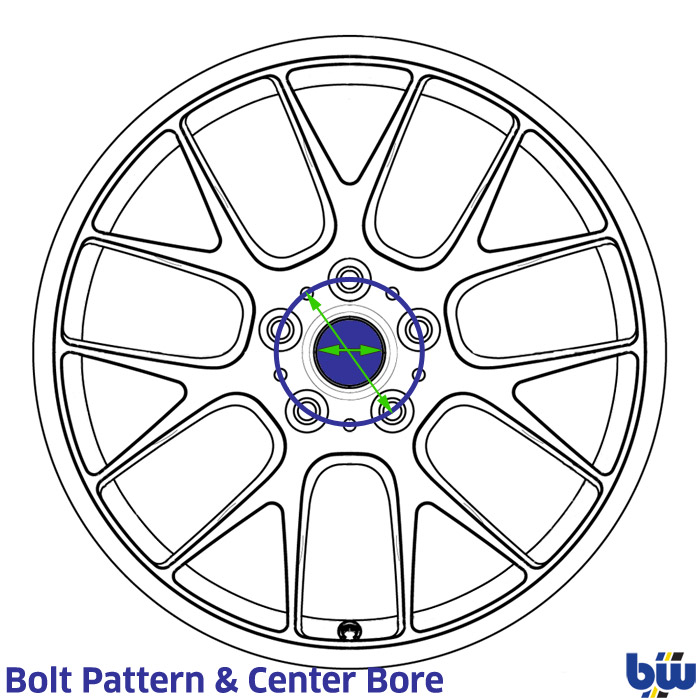
BMW Wheel Glossary & Terminology
Below you will find wheel diagrams based on our forged TA16 wheel that visually represent the terminology and components that make up an alloy wheel.
Click on each image and then use your arrow keys or tap to scroll through each diagram.
Wheel Manufacturing
How wheels are manufactured is a fascinating and amazing process. There are three ways to produce an aluminum wheel: cast, flow-formed, and forged.
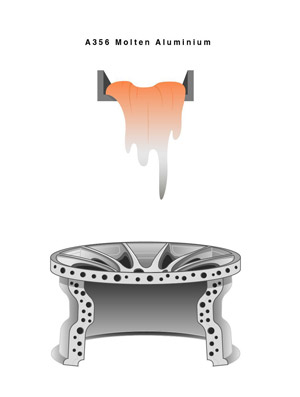
|
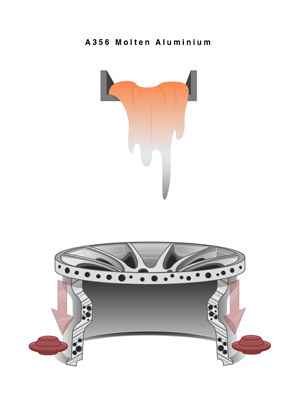
|
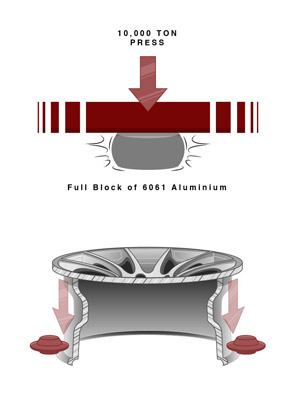
|
| Cast Wheels
Cast wheels use liquified molten aluminum that is poured into a steel mold. Cast wheels are one piece from that mold. But because it is a liquid first there is a greater number of air pockets or voids in the final product. This makes the wheel weaker overall, and more likely to bend or crack. To ensure the wheels have additional strength, they add thickness, which makes the wheel heavier. All major manufacturers submit their wheels for safety testing so cast wheels are generally strong enough for road use. |
Flow-Formed Wheels
Flow-forming is a relatively new process and results in a wheel that is stronger than cast but a little more expensive. The wheel is made just like a cast wheel with molten aluminum. The mold is special and the wheel comes out as a narrow but dense size. It's then placed on a machine, heated, and spun. Mandrels then apply pressure to the barrel and shape the casting into the familiar wheel barrel shape while compressing the material at the same time. This makes it similar to the forging process and is also where the term "spun forged" came from. While the face of the wheel is cast, the barrel has greater strength thanks to the denser material and fewer imperfections. Because it's stronger, the flow-formed wheel does not need extra thickness so it's lighter than a cast wheel also. Because of the high performance demands, most wheels we sell are flow-formed. |
Forged Wheels
Forged wheels start as a single block of solid billet aluminum cylinder. Billet aluminum blocks are made from a casting as well. But here is where forged products get their strength. The block is compressed using an hydraulic machine press. In the case of our BimmerWorld TA16 wheels, a 10,000 ton per square inch press is used. The previous high standard for wheels was 8,000 tons. The huge pressure eliminates any voids or air pockets and makes the aluminum extremely dense and strong. The billet block is pressed into roughly the shape of a wheel. Then the machining process can begin. CNC milling machines cut the billet into the final wheel shape. As you can imagine, it takes a long time for a single cutting bit to shape an 18" wheel. And in the case of high performance or racing wheels a lot of machining is done to make the wheel as light as possible. |
Videos:
Here are the best videos we have found that demonstrate the different wheel manufacturing processes.Cast:
Flow-Form:
Flo-form wheels start as a cast wheel center (see video) above. But the barrel is formed just like a forged wheel by rolling the barrel along a mandrel.
Forged:
This quick video shows the 10,000 ton press being used to squash the alloy block and some of the machining done on the forging.
Wheel Design & Testing
Wheels are designed on computers using finite element analysis (FEA). This powerful software can "test" a wheel's strength by simulating real-world forces. This validates the engineer's design. Computer software can also simulate the fitment of the wheel with big brake kits so that spoke and barrel designs will clear the calipers. But the computer modeling is just the initial step in designing a safe and strong wheel.Additional validation comes from tests done at the factory: a Dynamic Cornering Fatigue Test, a Dynamic Radial Fatigue Test, and an Impact Test. These tests are done to standards set by the SAE (US), JWL/VIA (Japan), and TUV (Germany). These tests are recognized internationally for testing the strength of wheels. JWL/VIA and TUV certification is required when selling wheels in Japan and Germany, respectively. Our TA16 wheels passed JWL/VIA test standards in 2015 and again in 2019 (re-testing is required every five years). Our TA5R wheels passed SAE tests in 2019.
However, no test or certification is required for selling wheels in the US. Unfortunately, many aftermarket wheels would not pass these tests which creates a very dangerous safety concern. BimmerWorld, and a few others, have always pushed for the highest quality and levels of safety in motorsport. Whether it's a rain light, racing harness, helmet, or wheel, we believe that safety matters above all else. Our wheels have been tested with these standards and we used them extensively in professional motorsports with exceptional results. And we continue advocating for the best and safest products on your BMW street and race car.
Additional real-world testing is carried out by our race team on tracks around the country. Our first in-house design, the TA16, was originally designed for our IMSA and World Challenge race programs. We relied on these wheels to get us through endurance races with actual wheel-to-wheel contact and occasional impacts with curbs. The TA16 was a contributing success to our 2018 IMSA Driver's Championship. Anything that could not endure those punishing conditions would not occupy a place in our program.
To Spacer or Not To Spacer?
The BimmerWorld View: the best wheel set for a BMW model is one that does not need spacers. The proper offset and size should always be used. However, that is not always practical or financially sensible. And that's where wheel spacers are vital and necessary. Consider them a "necessary
Wheel spacers allow you to run wheels you might not be able to use. A good example is 18x10" wheels on the F87 M2 Coupe. The ideal offsets are different for front and rear with a compromise of ET30. But ET30 does not exist unless you have custom forged wheels made (big $$$). But ET33 wheels are readily available and a small spacer gives us the proper clearance in the front. We saved a couple thousand dollars in wheel cost and can run a proper 275 tire instead of a smaller 18x9.0" or 18x9.5" wheel. A spacer is also typically lighter than using a wider wheel. As unsprung weight, a lighter wheel has many advantages.
Are wheel spacers safe? Any part used for motorsport has its limitations. When properly engineered to fit correctly there is no danger to them. The only time we have heard of wheel, hub, or hardware failures is when customary installation procedures were not followed. There is the theoretical argument that the spacer puts more strain on wheel bearings. In twenty years we have never seen actual proof of this. And we typically have a lighter wheel & tire combination that makes this argument a wash. Heat from the brakes and track temps are more likely to burn up wheel bearing grease faster anyway. Our M4 GT4 racecars come from BMW Motorsport with massive 32mm front wheel spacers so even factory engineers have adopted them.
With any spacer longer wheel bolts or studs are required. The appropriate length is the thickness of the spacer + your existing wheel bolts. Existing is preferred over stock bolts in case your wheels came with a bolt different than the stock length. Test install and tighten a longer wheel bolt and ensure it has the appropriate length of engagement (see chart below). Anything less than this and you will need a longer wheel bolt.
Wheel Bolt Engaged Length:
M12 x 1.25 = 8.0 turns = approximately 10mm of thread engagement
M12 x 1.5 = 6.5 turns = approximately 10mm of thread engagement (common BMW thread)
M12 x 1.75 = 6.5 turns = approximately 12mm of thread engagement
M14 x 1.25 = 9.0 turns = approximately 12mm of thread engagement (BMW E65, E83, E53 models)
M14 x 1.5 = 7.5 turns = approximately 12mm of thread engagement (common BMW thread)
1/2" UNF = 8.0 turns = approximately 11mm of thread engagement
BMW Wheel Spacer Fitments
Below are some diagrams showing how various BMW wheel spacer sizes fit on a typical hub.
From left to right, the components are: brake rotor disc, brake hat (backside), wheel hub face, wheel stud, brake hat (the thickness of the hat sits over the front of the hub), wheel spacer (except in tile #1 which is no spacer) (highlighted in blue), wheel hubcentric lip (highlighted in orange), and a wheel rim profile. Most of the components are to scale to one another.
Pay attention to the relationship of the hubcentric lip (highlighted in orange) and the fitment of the spacer. Most spacers from 10mm and above include a new hubcentric lip for the wheel to rest on. But 5mm uses the leftover existing lip. Also note how the available length on the stud gets shorter as the spacer gets thicker.
Click on each image and then use your arrow keys or tap to scroll through each diagram.
Spacer Chamfer Incompatibility
Many spacers use a chamfer between the spacer face and the new hubcentric lip. The chamfer adds extra support to the lip and more strength where stress risers exist. But with so many brands of spacers and wheels, and no industry standard for tolerances and machining, you could end up with a incompatible combination of parts.
It's very important that you pay attention to how these parts are mounted. The wrong combination of parts will lead to a failure and possibly cause the loss of a wheel and a crash.
On the backside of your wheel is a chamfer or bevel on the wheel pad. This makes it easier to slide the wheel on your hub. If the wheel has too small of a chamfer it will prevent the wheel from seating all the way on to the spacer. Or you could have a normal wheel chamfer but the chamfer on the spacer is too large. These are both the same problem: a gap exists between the wheel pad and the spacer face. If your spacer or your wheel wobbles when mounted you have a serious problem. See the images below or click the YouTube video for some visuals.
BimmerWorld Technical Alloy (TA) Wheels
BimmerWorld's wheel experience extends to designing our own wheels for BMWs. Our wheel program began in 2015 when we needed ultra-strong wheels for our racing program and the forged TA16 wheel was born. Since then we have expanded the TA16 forged offerings with more size options and added a flow-formed wheel in 2019 - the TA5R. Our TA wheels are tested to JWL/VIA and SAE standards for proper load ratings and then further punished on racing tracks around the world. Click the links below to learn more about our in-house brand of performance wheels for BMWs.Have further questions or want to talk this over with a human? Contact us by phone, 877-639-9648, or by email, [email protected].
Shop for BMW Wheels, Wheel Sets, Spacers, Studs & Bolts, and Accessories
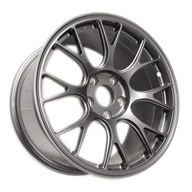
BMW Single Wheels |
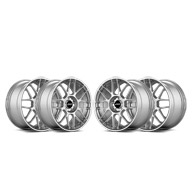
BMW Wheel Sets |
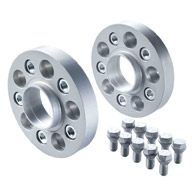
Wheel Spacers for BMW |
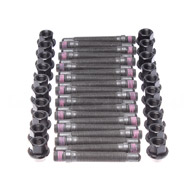
BMW Wheel Bolts & Studs |
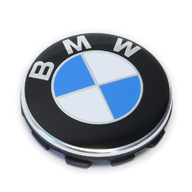
BMW Wheel Emblems & Accessories |
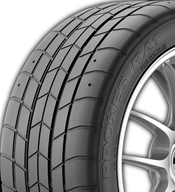
Tires for BMW |
| Sort by Name | Sort by Price |


